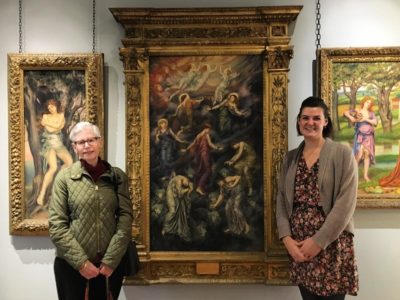 The last time I saw the De Morgan Foundation Collection it was in Wandsworth in a purpose-built gallery space which subsequently closed in 2014.
The last time I saw the De Morgan Foundation Collection it was in Wandsworth in a purpose-built gallery space which subsequently closed in 2014.
The relocation of the Foundation headquarters to the Watts Gallery in Compton along with the establishment of long-term loans to various properties throughout the UK has had the effect of raising the profile of this unique collection in the art world and making the works of Evelyn and William De Morgan accessible to a much larger audience.
As a longtime admirer of Evelyn’s oeuvreI was very eager to see her picturesnewly installed at the Watts Gallery and Wightwick Manor. On a recent trip to the U. K. I was not disappointed.
At both sites the De Morgan works have their own separate galleries where the work can really shine. Evelyn’s painting and William’s dazzling ceramics not only complement each other aesthetically but also demonstrate their life-long collaboration. This narrative of two artists, living together, supporting each other unconditionally, and dividing their time between Chelsea and Florence is a compelling personal story but also stunning in its artistic presentation.
At the Watts Gallery in Compton Evelyn’s beautifully colored The Storm Spirits beckon visitors into the gallery to see some of her other signature paintings. The Kingdom of Heaven Suffereth Violence and The Angel of Death are spiritualist allegories; Love of Mammon and The Gilded Cage demonstrate her concern about 19th C. materialism; and finally Cadence of Autumn is a lyrical reminder that metamorphosis is both natural and supernatural. William’s work, as always, demonstrates his keen study of Islamic pottery along with a playful sense of design. I was fortunate to be have indefatigable De Morgan Curator Sarah Hardy as my guide. She showed me a small display of letters and drawings she had just installed on the occasion of the Great War Armistice that are evidence of how preoccupied the couple was during that traumatic time.
At Wightwick Manor in Wolverhampton the De Morgan Collection is installed in the separate gallery called the Malthouse. Once again the ceramic and paintings are reminders of how important color and craft was to both artists. One senses that their annual sojourns in Florence were absolutely vital to their creative spirits. Here I was met with a staff full of expertise and enthusiasm for not only the house’s outstanding collection of Pre-Raphaelite art but now for the De Morgans as well. The Malthouse Gallery is dominated by paintings such as Helen of Troy, Cassandra, Venus and Cupid, andCadmus and Harmonia that show the influence of Evelyn’s classical training and her experiences in Italy. The lovely Symbolist allegory Night and Sleep clearly shows the combined influence of Edward Burne-Jones and the Pre-Raphaelites. We finally come full circle in De Morgan’s career with The Hour Glass. This paintingshows lessons learned from her uncle John Roddam Spencer Stanhope with its grace, strong color, and profusion of decorative and symbolic detail. It also uses as its model the De Morgans’s life-long friend and Pre-Raphaelite muse, Jane Burden Morris. Here Morris and De Morgan collaborate to show a female icon unafraid to be portrayed as an aging woman contemplating her mortality. It is a bold move worthy of both artist and model and a perfect end to a perfect day spent amongst the Victorians at Wightwick.
Buy the catalogue: https://www.demorgan.org.uk/shop/products/evelyn-de-morgan-oil-paintings
Image: Judy and Curator, Sarah Hardy, at the Watts Gallery – Artists’ Village





